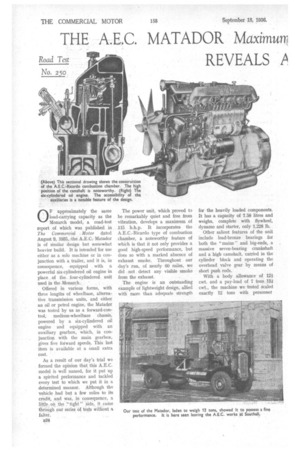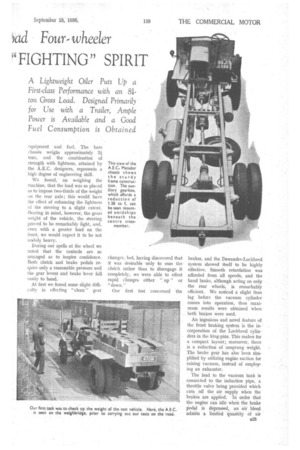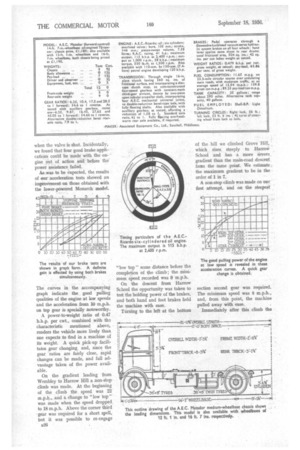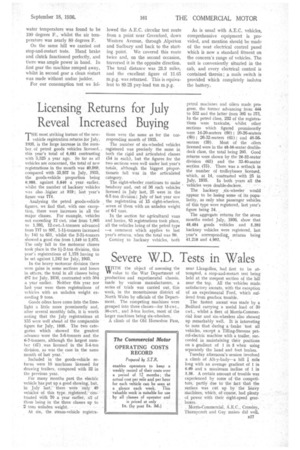THE A.E.C. MATADOR Maximum
Page 38

Page 39

Page 40

Page 41

If you've noticed an error in this article please click here to report it so we can fix it.
)ad Fourwheeler
REVEALS ,A G" SPIRIT
OF approximately the same load-carrying capacity as the Monarch model, a road-test report of which was published in The Commercial Motor dated August 9, 1935, 'the A.E.C. Matador is of similar design but somewhat heavier build. It is intended for use either as a solo machine or in conjunction with a trailer, and it is, in consequence, equipped with a powerful six-cylindered oil engine in place of the four-cylindered unit
used in the Monarch.. ,
Offered in various forms, with three lengths of wheelbase, alternative transmission units, and either an oil or petrol engine, the Matador was tested by us as a forward-control, medium-wheelbase chassis, powered by a six-cylindered oil engine and equipped with an auxiliary gearbox, which, in conjunction with the main gearbox, gives five forward speeds. This last item is available at a small extra cost.
As a result of our day's trial we formed the opinion that this A.E.C. model is well named, for it put up a spirited performance and tackled every test to which we put it in a determined manner. Although the vehicle had but a few miles to its credit, and was, in consequence, a little on the tight " Side, it .came through our series of tests without a falter.
1)24
The power unit, which proved to be remarkably quiet and free from vibration, develops a maximum of .115 b.h.p. It incorporates the A.E.C.-Ricardo type of combustion Chamber, a noteworthy feature of which is that it not only provides a good high-speed performance, but does so with a marked absence of exhaust smoke. Throughout our day's run, of nearly 60 miles, we did not detect any visible smoke from the exhaust.
The engine is an outstanding example of lightweight design, allied with more than adequate strength
for the heavily loaded components. It has a capacity of 7.58 litres and weighs, complete with flywheel, dynamo and starter, only 1,228 lb.
Other salient features of the unit include lead-bronze bearings for both the "mains" and big-ends, a massive seven-bearing crankshaft and a high camshaft, carried in the cylinder block and operating the overhead valve gear by means of short push rods.
With a body allowance of 124 cwt. and a pay-load of 7 tons .13f cwt., the machine we tested scaled exactly 12 tons with personnel equipment and fuel. The bare chassis weighs approximately 31t tons, and the combination of strength with lightness, attained by the A.E.C. designers, represents a high degree of engineering skill.
We found, on weighing the machine, that the load was so placed as to impose two-thirds of the weight on the rear axle; this would have the effect of enhancing the lightness of the steering to a slight extent. Bearing in mind, however, the gross weight of the vehicle, the steering proved to be remarkably light, and, even with a greater load on the front, we would expect it to be not unduly heavy.
During our spells at the wheel we noted that the controls are so arranged as to inspire confidence. Both clutch and brake pedals )require only a reasonable pressure and the gear levers and brake lever fall easily to hand.
At first we found some slight difficulty in effecting " clean " gear changes, but, having discovered that it was desirable only to ease the clutch rather than to disengage it completely, we were able to effect rapid changes either " up " or "down."
Our first test concerned the
brakes, and the Dewandre-Lockheed system showed itself to be highly effective. Smooth retardation was afforded from all speeds, and the hand brake, although acting on only the rear wheels, is remarkably efficient. We noticed a slight time lag before the vacuum cylinder comes into operation, thus maximum results were obtained when both brakes were used.
An ingenious and novel feature of the front braking system is the incorporation of the Lockheed cylinders in the king-pins. This makes for a compact layout ; moreover, there is a reduction of unsprung weight. The brake gear has also been simplified by utilizing engine suction for raising vacuum, instead of employing an exhauster.
The lead to the vacuum tank is connected to the induction pipe, a throttle valve being 'provided which cuts off the air supply when the brakes are applied. In order that the engine can idle when the brake pedal is depressed, an air bleed admits a limited Cluantity of air
when the valve is shut. Incidentally, we found that four good brake applications could be made with the engine out of action and before the power aSsistance As:was to be expected, the results of our acceleration tests showed an improVement on those obtained with the lower-pOwered Monarch model.
The curves in the accompanying graph indicate the good pulling qualifies of the engine at low speeds and the acceleration from 10 m.p.h. on top gear is specially noteworthy. A power-to-weight ratio of 0.47
b.h.p. per cwt., combined with th:-.1 characteristic mentioned above,
renders the vehicle more lively than one expects to find in a machine of its weight. A quick pick-up facilitates gear changing_ and, since the
gear -ratios are fairly close, rapid changes can be made, and full advantage taken of the power avail
able.
On the gradient leading from Wembley to Harrow 1E11 a non-stopclimb was made. At the beginning of the climb the speed was 22 and a change to "low top" was made when the speed dropped to 18 m.p.h. Above the corner third gear was required for a short spell, but it was possible to re-engage B26 "low top" some distance before the completion of the climb ; the minimum speed recorded was 9 na,p.h.
On the descent from Harrow School the opportunity was taken to test the holding power of the brakes, and both hand and foot brakes held
the machine with ease.
Turning to the left at the bottom of the hill we climbed Grove Fill , which rises steeply to Harrow School and has a more severe gradient than the main-road desceut, from the same point. We estimate:: the maximum gradient to be in the order of 1 in 7.
A non-stop climb was made on our first attempt, and on the steepest section second gear was required. The minimum speed was 8 m.p.h., and, from this point, the machine pulled away with ease.
Immediately after this climb the water temperature was found to be 190 degrees F., whilst the air temperature was nearly 80 degrees F.
On the same hill we carried out stop-and-restart tests. Hand brake and clutch functioned perfectly, and there was ample power in hand. In first gear the machine romped away, whilst in second gear a clean lestart was made without undue judder.
For our consumption test we fol lowed the A.E.C. circular test route from a point near Greenford, down Western Avenue, through Alperton and Sudbury and back to the starting point. We covered this route twice and, on the second occasion, traversed it in the opposite direction. The total distance was 23.3 miles, and the excellent figure of 11.65 m.p.g. was returned. This is equivalent to 89.23 pay-load ton m.p.g. As is usual with A.E.C. vehicles, comprehensive equipment is provided, and mention should be made of the neat electrical control panel which is now a standard fitment on the concern's range of vehicles. The unit is conveniently situated in the cab, and every electrical control is contained therein; a maih switch is provided which completely isolates the battery.




























































































